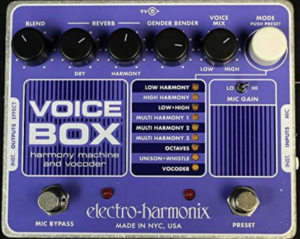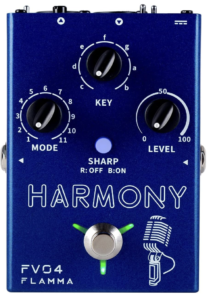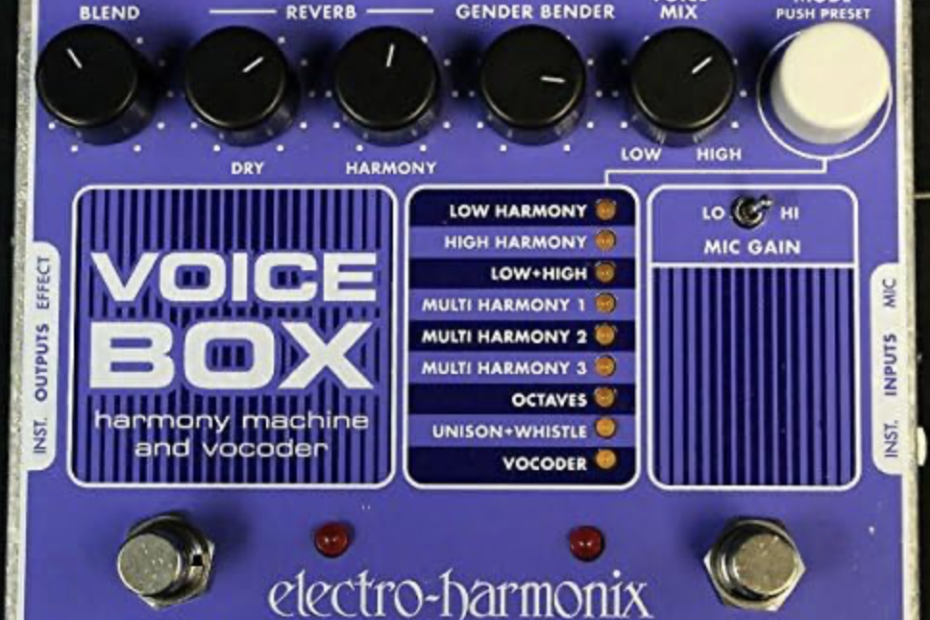The Electro-Harmonix Voice Box is a vocal harmony and effects pedal designed for singers and vocalists. Produced by Electro-Harmonix, a well-known manufacturer of guitar and audio effects pedals, the Voice Box offers a range of features to enhance and manipulate the user’s vocal performance.
Electro-Harmonix Features
 Here are some key aspects of the Electro-Harmonix Voice Box.
Here are some key aspects of the Electro-Harmonix Voice Box.
Harmony Generation
The pedal allows users to generate rich, realistic vocal harmonies in real-time. It can produce both single and multiple harmony voices, enabling singers to create harmonized arrangements for their vocals.
Effects Processing
In addition to harmonies and pitch correction, the Voice Box offers various effects such as reverb and echo to enhance the overall sound of the vocals.
The pedal typically features an intuitive control layout, making it user-friendly for both live performances and studio recordings. Users can easily adjust parameters such as harmony level, blend, and gender settings.
The Voice Box is often designed to be operated via a footswitch, allowing singers to engage or disengage the effect easily during performances.
Expression Pedal Input
Some versions of the Voice Box come equipped with an expression pedal input, enabling users to control certain parameters in real-time using an external expression pedal.
Electro-Harmonix is known for producing robust and reliable pedals, and the Voice Box is no exception. It is built to withstand the rigors of live performances and regular use.
See Also:
10 Best Flanger Guitar Pedals for 2024
Strymon Mobius Multidimensional Modulation Pedal
SONICAKE Multi Effects Processor Pedal
Source Audio C4 Synth Pedal Review
Vocoder Function
 The Vocoder function in a vocal effects pedal, like the Electro-Harmonix Voice Box, is a feature that allows you to modulate your voice with a synthesized signal, creating a distinctive robotic or electronic sound. This effect is widely used in various music genres, including electronic, pop, and hip-hop, to add unique textures and futuristic elements to vocals. Here are some key aspects of the Vocoder function:
The Vocoder function in a vocal effects pedal, like the Electro-Harmonix Voice Box, is a feature that allows you to modulate your voice with a synthesized signal, creating a distinctive robotic or electronic sound. This effect is widely used in various music genres, including electronic, pop, and hip-hop, to add unique textures and futuristic elements to vocals. Here are some key aspects of the Vocoder function:
The Vocoder combines two signals – the carrier signal and the modulator signal. Your vocal input serves as the modulator, and a synthesized sound or instrumental signal (often generated by the pedal itself or an external source) acts as the carrier.
The modulator signal (your voice) is split into multiple frequency bands. Each band is then modulated by the corresponding frequency band of the carrier signal. This modulation process creates the characteristic robotic or harmonically rich sound of a vocoder.
The carrier signal can be a synthesized waveform, such as a sawtooth or square wave, or even a sampled instrument sound. This allows for a wide range of sonic possibilities, from classic vocoder sounds to more experimental and creative effects.
Gender Bender Control
Some vocoders, including the Electro-Harmonix Voice Box, may have a “Gender Bender” control. This parameter adjusts the balance between masculine and feminine qualities in the synthesized harmonies, allowing you to shape the character of the vocoded sound.
Vocoder pedals typically include controls for adjusting the balance between your dry (unprocessed) vocal signal and the vocoded output. This allows you to find the right mix for your performance.
Some vocoders, like the Voice Box, offer an expression pedal input. This allows you to control certain parameters, such as the level of the vocoder effect, in real-time using an external expression pedal.
Beyond traditional vocoding, artists often use vocoders creatively to produce unique vocal textures. Experimenting with different carrier signals, modulation settings, and blending options can result in a wide array of interesting and experimental sounds.
Vocoder effects are popular in both live performances and studio recordings. In a live setting, vocalists can use vocoders to add a futuristic touch to their vocals, while in the studio, the vocoder is a versatile tool for creating unique and layered vocal arrangements.
How to Use the Electro-Harmonix
 Using the Electro-Harmonix Voice Box pedal involves a few steps to set up and customize the vocal effects according to your preferences. Here’s a general guide on how to use the pedal:
Using the Electro-Harmonix Voice Box pedal involves a few steps to set up and customize the vocal effects according to your preferences. Here’s a general guide on how to use the pedal:
- Connectivity:
- Connect your microphone to the “Mic In” or “XLR In” on the pedal.
- Connect the pedal’s output (either “Main Out” or “XLR Out”) to your mixer, audio interface, or PA system.
- Power Supply:
- Power the pedal using the appropriate power supply. Ensure you’re using the correct voltage and polarity to avoid damaging the pedal.
- Controls:
- Familiarize yourself with the pedal’s controls. The specific controls may vary based on the version, but common ones include:
- Harmony Level: Adjusts the volume of the generated harmonies.
- Blend: Controls the balance between your dry (original) vocal and the processed signal.
- Gender Bender: Adjusts the gender of the harmonies, allowing you to make them sound more masculine or feminine.
- Reverb and Echo: Controls for adding reverb and delay effects to your vocals.
- Harmony and Mode Selector: Choose the type and number of harmony voices.
- Familiarize yourself with the pedal’s controls. The specific controls may vary based on the version, but common ones include:
- Pitch Correction:
- If your Voice Box has pitch correction, set the correction level to your preference. This helps keep your vocals in tune.
- Vocoder Mode (if applicable):
- If you’re using the vocoder feature, select the vocoder mode and adjust the parameters accordingly.
- Expression Pedal (if applicable):
- If your Voice Box has an expression pedal input, connect an expression pedal to control parameters such as harmony level or gender in real-time.
- Engaging the Effect:
- Use the footswitch to engage or bypass the effect. This allows you to turn the vocal processing on and off during your performance.
- Experiment and Fine-Tune:
- Spend some time experimenting with different settings to find the harmonies and effects that suit your style. Fine-tune the controls based on your performance needs and the specific song you’re working on.
- Save Settings (if applicable):
- Some versions of the Voice Box may have the ability to save presets. If so, explore how to save and recall your favorite settings for different songs.
- Practice:
- Practice with the pedal to get comfortable with its features and how it responds to your vocal input. This will help you use it more effectively during live performances or studio recordings.
Comparing the Electro-Harmonix Voice Box to Other Products
Here are some products that compare to the Electro-Harmonix.
- TC-Helicon Harmony Singer 2:
- Comparison: Similar to the Voice Box, the Harmony Singer 2 offers vocal harmonies and pitch correction. It has a user-friendly interface, but it may not include the vocoder feature found in the Voice Box.
- Boss VE-20 Vocal Performer:
- Comparison: The VE-20 by Boss is a versatile vocal processor with features like harmonies, pitch correction, and various effects. It has a durable build and may offer a broader range of effects compared to the Voice Box.
- DigiTech Vocalist Live Harmony:
- Comparison: The Vocalist Live Harmony series from DigiTech provides vocal harmonies and pitch correction. Depending on the model, it may include advanced features like adaptive harmony technology.
- Eventide H9 Harmonizer:
- Comparison: The H9 is a multi-effects pedal that can be used for various instruments, including vocals. It offers high-quality harmonization and pitch effects, but it’s a more comprehensive and expensive unit compared to the Voice Box.
- Roland VT-4 Voice Transformer:
- Comparison: The VT-4 is a voice transformer that includes pitch shifting, vocoding, and various vocal effects. It may not have as extensive harmony features as the Voice Box, but it’s a compact and versatile option.
- Zoom V6 Vocal Processor:
- Comparison: The Zoom V6 provides vocal processing with harmony effects, pitch correction, and various vocal effects. It has a user-friendly interface and may be a more budget-friendly option compared to some others on the list.
